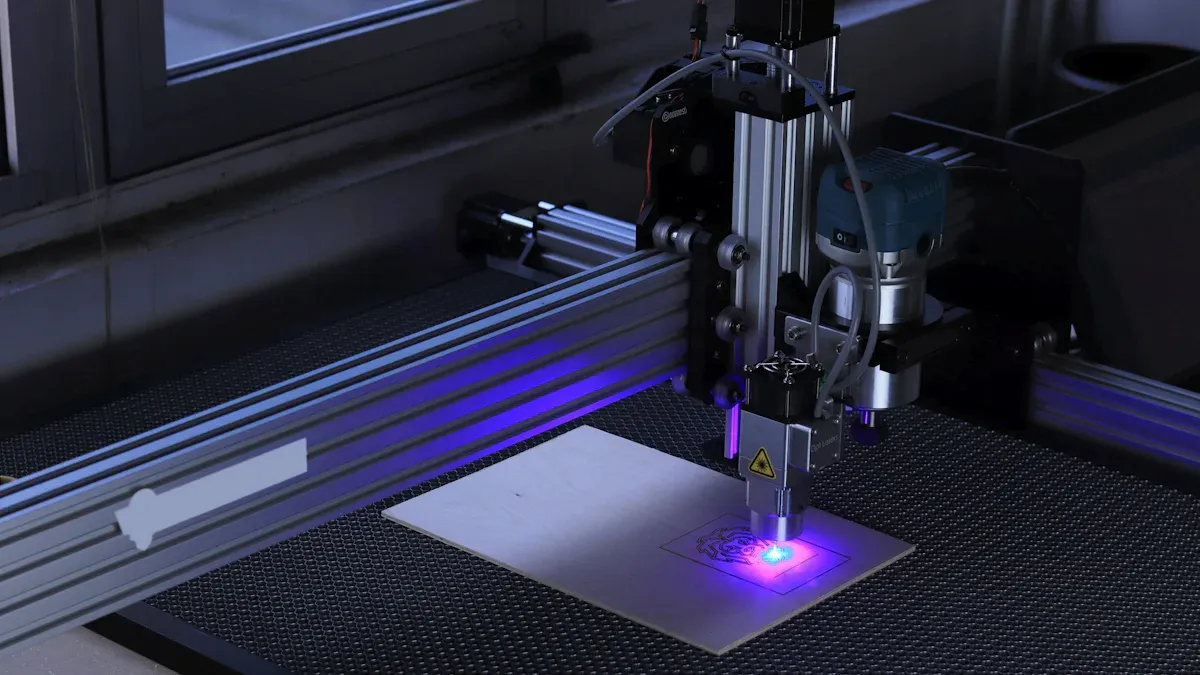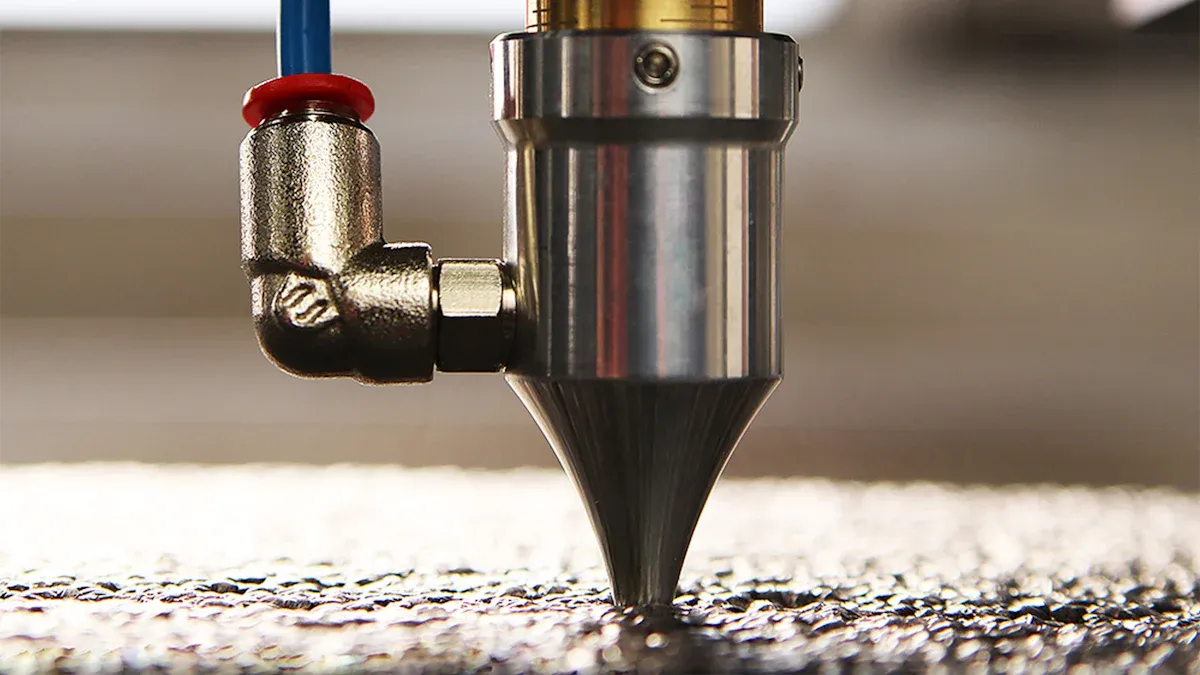How to Overcome Challenges in Nickel-Titanium Alloy Laser Micromachining

Nickel–titanium alloy laser micromachining presents unique challenges due to the material's shape-memory effect and pseudoelasticity. These properties increase sensitivity to variations in manufacturing parameters and cooling rates, often disrupting the microstructure. Additionally, issues like size effects, machine tool vibrations, and tool-workpiece interactions further hinder machining efficiency and precision. Addressing these challenges is crucial, as nickel–titanium alloys are increasingly used in innovative products. Advanced laser technologies play a pivotal role in overcoming challenges by enabling precise control over machining parameters, ensuring better outcomes for industries relying on this material.
Key Takeaways
Nickel-titanium alloys are special and hard to machine. Knowing their traits helps get better results.
Adjusting laser settings, like pulse time and energy strength, makes machining easier and surfaces smoother.
Good cooling methods, like very cold cooling, lower heat effects and keep the material strong.
Watching the process in real-time helps work faster and fix mistakes quickly.
Using green methods in laser machining cuts waste and saves energy, helping the environment.
Key Challenges in Nickel–Titanium Alloy Laser Micromachining

Thermal Effects
Thermal effects significantly influence the precision and quality of nickel–titanium alloy laser micromachining. Heat generated during machining can alter the material's microstructure, leading to surface quality issues. The heat-affected zone (HAZ) often becomes a critical area of concern, as excessive heat can compromise the machinability of the material. Shorter laser pulses, such as femtosecond pulses, reduce thermal effects by limiting heat transfer to surrounding areas. Pulsed mode lasers also enhance quality by minimizing unwanted thermal changes. However, longer pulse durations can negatively impact reflectivity and absorption rates, further complicating machining processes. Effective thermal management is essential to maintain high-quality outcomes and prevent defects.
Material Properties
Nickel–titanium alloys exhibit unique properties that pose challenges during machining. The shape-memory effect allows these alloys to return to their original shape after deformation, complicating precision machining tasks. Pseudoelasticity further adds to the complexity by causing unpredictable material behavior under laser processing conditions. These characteristics make it difficult to achieve consistent results, especially when working with high strength-toughness alloys. Understanding these material properties is crucial for optimizing machining strategies and improving surface quality.
Challenges in Milling Operations
Milling operations for nickel–titanium alloys share similarities with the machinability of Ti6Al4V alloy. Both materials exhibit low thermal conductivity, leading to high temperatures during machining. This can cause phase transformations, hardening the material and increasing cutting stresses. Additionally, the alloys tend to become sticky at elevated temperatures, resulting in poor chip evacuation and the formation of a Built-Up Edge on the cutting tool. These challenges in milling operations often lead to reduced machinability and compromised quality. Addressing these issues requires advanced techniques and tools designed specifically for high strength-toughness alloys.
Solutions for Overcoming Challenges
Laser Parameter Optimization
Optimizing laser parameters is essential for addressing challenges in nickel–titanium alloy laser micromachining. Multi-objective optimization plays a critical role in achieving precise results. Key parameters such as laser pulse duration, energy density, and scanning speed must be carefully adjusted to enhance machinability and quality. Ultrafast femtosecond pulse processing has shown promising outcomes, particularly in manufacturing medical devices. This technique increases cutting speed, improving throughput while maintaining surface integrity control. By fine-tuning these parameters, machining strategies can overcome the complexities posed by the material's unique properties.
Cooling and Heat Management
Effective cooling methods are vital for minimizing thermal effects during machining. Advanced cooling techniques, such as cryogenic cooling and air-assisted systems, help reduce the heat-affected zone. This ensures better material integrity and tighter tolerances. Shorter laser pulses, like those from femtosecond lasers, further enhance ablation efficiency by limiting heat transfer to surrounding areas. These strategies improve overall quality and repeatability, making them indispensable for laser-assisted machining. Incorporating advanced cooling techniques into machining processes ensures consistent results and addresses the challenges associated with heat management.
Advanced Monitoring and Control
Real-time monitoring systems significantly enhance the efficiency of laser-assisted machining. These systems provide online oversight, enabling operators to forecast outcomes, identify errors, and refine machining strategies. Multi-sensor systems collect diverse real-time data, which is crucial for managing the rising pulse repetition rates and scanning speeds in ultrashort pulse laser micromachining. This approach ensures high-quality results and reduces downtime. Advanced monitoring tools also streamline parameter investigations, making them a cornerstone of modern machining practices. By integrating these technologies, manufacturers can address challenges effectively and maintain consistent quality.
Case Studies in Nickel–Titanium Alloy Laser Micromachining
Medical Device Manufacturing
Nickel–titanium alloy laser micromachining has revolutionized the production of medical devices. The unique properties of nickel–titanium alloys, such as the shape-memory effect and pseudoelasticity, make them ideal for creating intricate components. Laser micromachining is the preferred method for manufacturing these devices due to its precision and ability to maintain material integrity.
Ultrafast pulse lasers (USP) play a critical role in this process. They provide high precision and minimal thermal impact, resulting in excellent cut quality and clean edges. This reduces the heat-affected zone, minimizing the need for extensive post-processing. These advantages are particularly beneficial for delicate components like neurovascular stents, cannulae, needles, and small-diameter tubes. USP lasers also improve production efficiency by reducing part breakage, which lowers costs and increases yield.
The machinability of nickel–titanium alloys in medical applications has led to the creation of intricate features and high-quality surfaces. These qualities are essential for devices that require precision and reliability. As a result, nickel–titanium alloy laser micromachining has become a cornerstone of innovation in the medical device industry.
Aerospace Applications
The aerospace industry relies on nickel–titanium alloy laser micromachining to meet its stringent requirements for precision and durability. Components used in aerospace applications must withstand extreme conditions, including high temperatures and mechanical stress. Nickel–titanium alloys, with their exceptional strength and resilience, are well-suited for these demands.
Laser micromachining enables the production of complex geometries and high-quality surfaces required for aerospace components. The process ensures tight tolerances and consistent results, addressing the challenges posed by the material's unique properties. For example, the low thermal conductivity of nickel–titanium alloys, similar to Ti6Al4V, can lead to high temperatures during machining. Advanced laser techniques mitigate these issues by optimizing heat management and improving machinability.
The aerospace sector benefits from the precision and efficiency of laser micromachining. By overcoming challenges like phase transformations and cutting stresses, manufacturers can produce reliable components that meet industry standards. This makes nickel–titanium alloy laser micromachining an indispensable tool for advancing aerospace technology.
Emerging Trends in Laser Micromachining

Advancements in Laser Technology
Recent advancements in laser technology have significantly enhanced the precision and efficiency of nickel–titanium alloy laser micromachining. Ultrafast femtosecond pulse processing has emerged as a game-changer, particularly in manufacturing medical devices. This technology enables localized near-athermal ablation, minimizing heat transfer to surrounding areas. As a result, it produces highly repeatable features with tolerances as low as +/- 2.5 µm.
Pulsed mode lasers also play a pivotal role in improving machinability. By concentrating energy in small pulses, they reduce the heat-affected zone, ensuring better surface quality. These advancements address challenges like cutting speed, which has traditionally been slower than conventional methods. The ability to create smaller features with fewer defects makes ultrashort pulse lasers indispensable for industries requiring high precision.
Key advancements include:
Enhanced cutting speed and precision through ultrafast femtosecond pulse processing.
Improved machinability of Nitinol medical devices due to its unique properties like pseudoelasticity.
Reduced thermal effects, leading to better quality and fewer defects.
Sustainable Machining Practices
Sustainability has become a critical focus in machining processes. Laser micromachining offers several eco-friendly advantages, making it a preferred choice for industries aiming to reduce their environmental footprint. Unlike traditional methods, laser machining minimizes material waste by enabling precise cuts and reducing the need for extensive post-processing.
Cryogenic cooling and air-assisted systems further enhance sustainability by lowering energy consumption during machining. These techniques not only improve machinability but also ensure consistent quality. By adopting sustainable practices, manufacturers can address challenges related to resource efficiency while maintaining high standards of production.
Future Applications
The unique characteristics of nickel–titanium alloys, such as the shape-memory effect and pseudoelasticity, position them as ideal materials for innovative product development. Advancements in laser micromachining have opened new possibilities for emerging industries. For instance, ultrashort pulse lasers enable the creation of intricate features with excellent finish quality, making them suitable for cutting and drilling ceramic semiconductor wafers, etching solar cells, and machining fuel injector nozzles.
The medical device sector continues to benefit from these advancements, particularly in producing components for minimally invasive surgical techniques. The aerospace industry also leverages these technologies to meet its stringent requirements for precision and durability. As laser micromachining evolves, its applications will expand into other fields, driving innovation and addressing machining challenges across industries.
Nickel–titanium alloy laser micromachining presents unique challenges due to the material's shape-memory effect and pseudoelasticity. These properties complicate machining processes, requiring precise control over parameters to maintain quality. Optimizing laser cutting processes, particularly through ultrafast femtosecond pulse processing, has proven effective in improving machinability. However, cutting speed remains a significant hurdle, being over four times slower than long pulse cutting. Addressing these challenges ensures better throughput and competitiveness in industries like medical devices and aerospace.
Emerging trends in laser micromachining continue to drive innovation. The increasing popularity of nickel–titanium alloys for new product development highlights the importance of advancements in machining techniques. These innovations enhance machinability and market efficiency, making laser micromachining the preferred method for manufacturing Nitinol-based products. By adopting advanced techniques like laser parameter optimization and AccuPath, manufacturers can achieve precision and consistency. Exploring these trends will help industries stay competitive and unlock new possibilities for nickel–titanium alloy applications.
FAQ
What makes nickel–titanium alloys challenging to machine?
Nickel–titanium alloys exhibit unique properties like the shape-memory effect and pseudoelasticity. These characteristics cause unpredictable material behavior during machining. Additionally, their low thermal conductivity leads to excessive heat generation, complicating precision and surface quality.
How does laser micromachining improve precision?
Laser micromachining uses ultrafast pulses to focus energy on specific areas. This minimizes the heat-affected zone and reduces thermal damage. The process ensures tight tolerances and consistent results, making it ideal for intricate designs.
Why is cooling important in laser micromachining?
Cooling prevents excessive heat buildup, which can alter the material's microstructure. Techniques like cryogenic cooling and air-assisted systems enhance material integrity and improve machining quality by reducing thermal effects.
What industries benefit most from nickel–titanium laser micromachining?
The medical and aerospace industries benefit significantly. Medical devices like stents and needles require precision, while aerospace components demand durability and tight tolerances. Laser micromachining meets these requirements effectively.
Are sustainable practices possible in laser micromachining?
Yes, laser micromachining supports sustainability by reducing material waste and energy consumption. Techniques like cryogenic cooling and precise cutting minimize environmental impact while maintaining high production standards.
See Also
Understanding Nickel Titanium's Role in Healthcare Innovations
Comprehensive Overview of Nitinol Parts and Production Methods
Why NiTi Tubes Revolutionize Medical and Aerospace Industries

